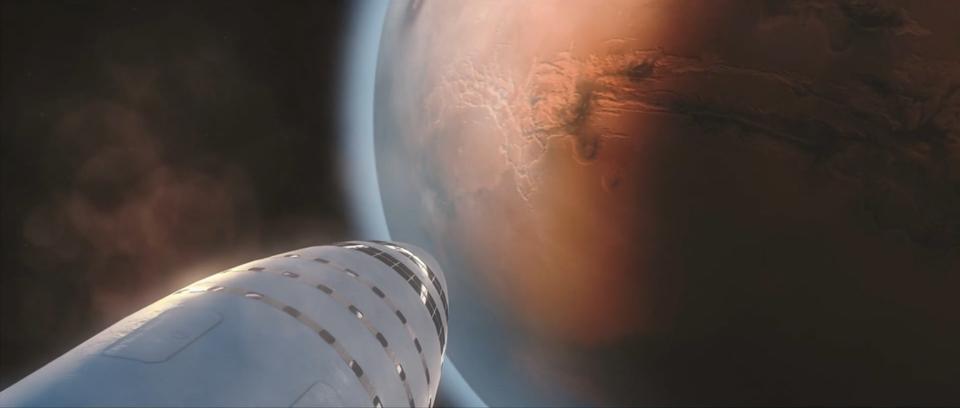Another source said
Musk believes humanity needs to leave Earth to ensure the survival of our species in the case of catastrophe or disaster.
On Tuesday December 10, two days after SpaceX’s starship launch was cancelled a mere 1.3 seconds before lift-off, the giant gleaming steel rocket exploded on landing after reaching an altitude of 12.5 km, performing a flip and returning back to its launch pad.
A week earlier, SpaceX’s founder Elon Musk gave the test flight 2 in 3 chances of failure. In a bout of excitement, he tweeted out, “Mars, here we come!!”
But even before the failure of its largest prototype spaceship, SpaceX was already busy working on two newer prototypes. For Musk, who has single-handedly revitalised spaceflight, it’s all about moving fast, learning from mistakes, and developing technology and engineering methods that haven’t even been created yet, on the go, on the fly.
SpaceX knew many things could go wrong with Starship. After all, the first two Starships blew up.
But that’s the idea. SpaceX’s engineers have a daily struggle with the very difficult challenge of getting the world’s largest spaceship and rocket out of Earth’s gravity into orbit, while ensuring that it can land, and fly again.
For Musk, the only way this can be achieved is through trial and error, getting closer and closer to the right design everytime.
That’s exactly what SpaceX did to its ‘Raptor’ engine.
“Like, we’re on Raptor engine 23 or something, Maybe 24. It’s lighter, cheaper, better in almost every way than Raptor version one, which sucked and blew up, basically. One of about six or seven Raptors that blew up, I’ve lost count.”
The current (eighth) Starship prototype the company tried to launch is 16 stories tall. What’s more, it’s not even complete. It will require another 23-storey booster rocket to lift it into orbit while preserving its fuel, before yet another rocket refuels it in space.
Musk’s vision is to eventually build one Starship a week.
"I think we need, probably, on the order of 1,000 ships," he says.
Why the tall order?
SpaceX eventually wants to launch an average of three Starship rockets a day, each carrying a 100-ton payload. A 1,000 Starship fleet would be capable of taking nearly 100,000 people to Mars everytime their planetary orbits sync, or every 26 months.
It all adds up to the golden number Musk keeps referring to. One million people. That’s how many people he believes need to live on Mars for the population to become sustainable, and distinct from earth. More specifically, that’s how many people he estimates are needed to recreate Earth’s entire industrial base, so that they can build, manufacture or process anything without relying on earth.
At the heart of it all, Musk is driven by the need to ensure humanity becomes a multi-planetary species, which he believes is essential to our survival. “If something goes wrong with planet Earth, he pontificates, “that’s it. It’s game over.”
When he set out to realise his dream of colonising Mars, Musk quickly realised it was prohibitively expensive to push anything out of Earth’s orbit.
NASA used to pay $94,996 per kilogram of weight on any given mission. Some Space Shuttle missions cost upwards of half a billion dollars, and once booster rockets got a Space Shuttle into space, they were discarded and fell back into the ocean.
That was until Musk happened. One of SpaceX’s first priorities was reducing the cost of launches by building a self-landing rocket. After multiple crashes and burns, SpaceX finally succeeded in landing a rocket in 2016, 12 years after it was founded. A landing rocket was a rocket that could be reused multiple times, improving the company's profits, and bringing Musk's dreams closer to reality.
SpaceX currently charges around $150 million for 70 tons of payload delivered to low earth orbit. That amounts to nearly $285 a kilogram, a far cry from the old days of spaceflight. Musk wants to lower that further, to $10 a kilogram, which would make it viable to send people to Mars.
After pushing for development into better, more powerful engines, SpaceX quickly became a NASA and Department of Defence private contractor, offering budget space delivery with great value. The profits it made were reinvested in bigger rockets and stronger engines to make the commercial launches it does for NASA seem relatively tiny.
SpaceX has since supplanted NASA in the space race. In February 2019, an independent report requested by the US House of Representatives to determine if NASA could fly past Mars in 2033 concluded that the orbital mission would be “infeasible”, believing 2039 to be a more realistic date.
Not to be outperformed, Amazon’s owner Jeff Bezos set up Blue Origin, which also has its eyes on Mars and a slice of the solar pie. After all, space holds deep commercial promise and a new frontier of unexploited resources. One NASA report estimated that metals and minerals found in our solar system’s asteroid belt could exceed $100 billion for six billion people on earth.
But why Mars?
Musk believes it's for lack of a better choice. Venus has lead-melting temperatures, crushing atmospheric pressure, acidic rain and hot winds. Earth’s moon doesn’t have much in the way of resources, not to mention no atmosphere. With a day equal to 29 Earth days, the lack of atmosphere would make life incredibly cold, or hot. Mercury is similarly hot during the day, and incredibly cold at night.
Jupiter, Saturn, Uranus and Neptune are just condensed balls of gas that can never be habitable, with incredible amounts of pressure at their surface. Jupiter and Saturn’s moons are possible candidates, but they’re further and colder than Mars. Pluto is even further and colder.

Comments
Post a Comment